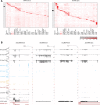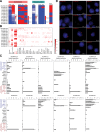Global discovery of erythroid long noncoding RNAs reveals novel regulators of red cell maturation
- PMID: 24200680
- PMCID: PMC3901070
- DOI: 10.1182/blood-2013-10-530683
Global discovery of erythroid long noncoding RNAs reveals novel regulators of red cell maturation
Abstract
Erythropoiesis is regulated at multiple levels to ensure the proper generation of mature red cells under multiple physiological conditions. To probe the contribution of long noncoding RNAs (lncRNAs) to this process, we examined >1 billion RNA-seq reads of polyadenylated and nonpolyadenylated RNA from differentiating mouse fetal liver red blood cells and identified 655 lncRNA genes including not only intergenic, antisense, and intronic but also pseudogene and enhancer loci. More than 100 of these genes are previously unrecognized and highly erythroid specific. By integrating genome-wide surveys of chromatin states, transcription factor occupancy, and tissue expression patterns, we identify multiple lncRNAs that are dynamically expressed during erythropoiesis, show epigenetic regulation, and are targeted by key erythroid transcription factors GATA1, TAL1, or KLF1. We focus on 12 such candidates and find that they are nuclear-localized and exhibit complex developmental expression patterns. Depleting them severely impaired erythrocyte maturation, inhibiting cell size reduction and subsequent enucleation. One of them, alncRNA-EC7, is transcribed from an enhancer and is specifically needed for activation of the neighboring gene encoding BAND 3. Our study provides an annotated catalog of erythroid lncRNAs, readily available through an online resource, and shows that diverse types of lncRNAs participate in the regulatory circuitry underlying erythropoiesis.
Figures







Comment in
-
Long noncoding RNAs in erythropoiesis.Blood. 2014 Jan 23;123(4):465-6. doi: 10.1182/blood-2013-12-538306. Blood. 2014. PMID: 24458276
Similar articles
-
Novel roles for KLF1 in erythropoiesis revealed by mRNA-seq.Genome Res. 2012 Dec;22(12):2385-98. doi: 10.1101/gr.135707.111. Epub 2012 Jul 26. Genome Res. 2012. PMID: 22835905 Free PMC article.
-
Long noncoding RNAs in erythropoiesis.Blood. 2014 Jan 23;123(4):465-6. doi: 10.1182/blood-2013-12-538306. Blood. 2014. PMID: 24458276
-
Ldb1 complexes: the new master regulators of erythroid gene transcription.Trends Genet. 2014 Jan;30(1):1-9. doi: 10.1016/j.tig.2013.10.001. Epub 2013 Nov 27. Trends Genet. 2014. PMID: 24290192 Free PMC article. Review.
-
Ldb1-nucleated transcription complexes function as primary mediators of global erythroid gene activation.Blood. 2013 May 30;121(22):4575-85. doi: 10.1182/blood-2013-01-479451. Epub 2013 Apr 22. Blood. 2013. PMID: 23610375 Free PMC article.
-
Networking erythropoiesis.J Exp Med. 2010 Nov 22;207(12):2537-41. doi: 10.1084/jem.20102260. J Exp Med. 2010. PMID: 21098097 Free PMC article. Review.
Cited by
-
Long non-coding RNAs: spatial amplifiers that control nuclear structure and gene expression.Nat Rev Mol Cell Biol. 2016 Dec;17(12):756-770. doi: 10.1038/nrm.2016.126. Epub 2016 Oct 26. Nat Rev Mol Cell Biol. 2016. PMID: 27780979 Review.
-
Long non-coding RNAs during normal erythropoiesis.Blood Sci. 2019 Oct 21;1(2):137-140. doi: 10.1097/BS9.0000000000000027. eCollection 2019 Oct. Blood Sci. 2019. PMID: 35402813 Free PMC article.
-
Circulating long non-coding RNA GAS5 (growth arrest-specific transcript 5) as a complement marker for the detection of malignant mesothelioma using liquid biopsies.Biomark Res. 2020 May 13;8:15. doi: 10.1186/s40364-020-00194-4. eCollection 2020. Biomark Res. 2020. PMID: 32435497 Free PMC article.
-
Profiles of Long Noncoding RNAs in Human Naive and Memory T Cells.J Immunol. 2017 Jul 15;199(2):547-558. doi: 10.4049/jimmunol.1700232. Epub 2017 Jun 9. J Immunol. 2017. PMID: 28600289 Free PMC article.
-
A computationally constructed ceRNA interaction network based on a comparison of the SHEE and SHEEC cell lines.Cell Mol Biol Lett. 2016 Sep 26;21:21. doi: 10.1186/s11658-016-0022-0. eCollection 2016. Cell Mol Biol Lett. 2016. PMID: 28536623 Free PMC article.
References
-
- Cantor AB, Orkin SH. Transcriptional regulation of erythropoiesis: an affair involving multiple partners. Oncogene. 2002;21(21):3368–3376. - PubMed
-
- Bertone P, Stolc V, Royce TE, et al. Global identification of human transcribed sequences with genome tiling arrays. Science. 2004;306(5705):2242–2246. - PubMed
-
- Carninci P, Kasukawa T, Katayama S, et al. FANTOM Consortium; RIKEN Genome Exploration Research Group and Genome Science Group (Genome Network Project Core Group) The transcriptional landscape of the mammalian genome. Science. 2005;309(5740):1559–1563. - PubMed
Publication types
MeSH terms
Substances
Grants and funding
LinkOut - more resources
Full Text Sources
Other Literature Sources
Molecular Biology Databases

